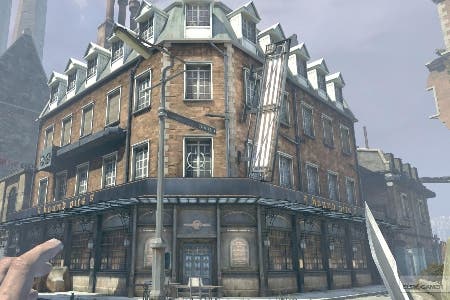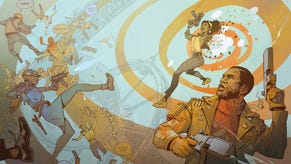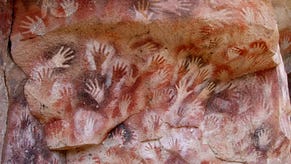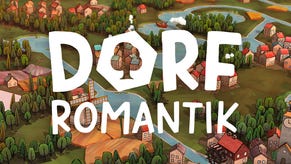Peeling back the layers of Dishonored with Harvey Smith and Raph Colantonio
From Sokolov's first painting to the third floor of the Hound Pits and beyond.
Bethesda Softworks doesn't do post-mortems. That's always been the line, which is why it's pretty rare for anyone to get to speak to one of the publisher's studios about a recently released game. We've never been able to look back at Skyrim with Todd Howard or talk to Tim Willits in hindsight about Rage, when at times during those games' development they and we were probably all sick of the sight of each other. We've never even spoken to that sweary lunatic who was involved in Rogue Warrior. Demo Dick! That was his name. Actually, there are probably other reasons we've never spoken to Demo Dick.
But when Dishonored came out, we were determined to get back in touch with co-creative directors Harvey Smith and Raph Colantonio, if only for one very important reason: we had to know what was going on with the third floor of the Hound Pits.
For those who missed it at the time, during the first few days of Dishonored's public life we spent hours trying to break into the bricked-up third floor of the game's charismatic hub level. We crawled up and down every vent, climbed every chain, used every power and explosive we could find, and stared through the veil of Dark Vision into its murky, lifeless interior, straining for some clue or detail as to its contents. We had to know.
"Originally there was a third floor and it's funny that you touch on that subject," says Raph Colantonio when we finally get to speak to him and Smith a month on from the game's release. "If you ask any level designer, from the outside a building will always look too big and inside it will look too small. It's a weird reality about level design. However, it's part of our values that we like to go around buildings and go on top of the roof and in the cellar if there is one. We like the environment to be real because it contributes to the immersion." Yes, yes, sure, great, but...? "However, one of the challenges here was that from outside it was really cool to have this tall building, but from inside there was a lot of stair-climbing, so we had to find at some point a trick to keep both."
Harvey Smith takes over as we slowly start to realise what we're being told. "I find it funny because I remember how frustrated Raph was specifically with that. As co-creative directors we both had our issues - we would come into work and rage at people about things, and for him that was one of them. At first we had another Hound Pits pub and we shrank it into a more Edwardian style pub - that was step one. Not enough. Still it was labyrinthine, too many stairs, too many rooms so you couldn't find what you were looking for, so the next thing is Raph asked for a chain to be hung outside the player's window so he could jump out and climb up to the roof.
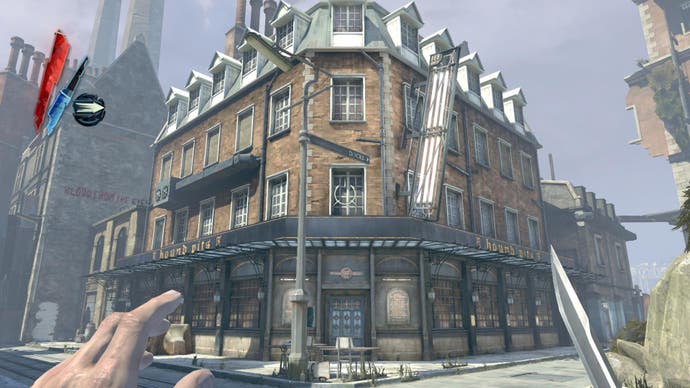
"Finally, we were still struggling and frustrated, and one day we were just like, 'F*** it, brick up the third floor!' I think the level designers had a heart attack, but it worked out in the end." Oh. "It's neat, because somebody asked me on Twitter the other day why it's bricked up, and obviously I could tell from their tone they were intrigued, so I said, 'Something terrible happened there...'"
"One day we were just like, 'F*** it, brick up the third floor!'"
Harvey Smith, Dishonored co-creative director
It is fair to say that, as a team, we spent longer trying to break into the third floor of the Hound Pits pub than we have spent playing some entire games this year. And, hearing the developers' explanation a few weeks later, the funny thing is that it's hard to regret any of it. It was so much fun trying to break onto that floor. One of the reasons Dishonored is ridiculously appealing to a certain kind of gamer is that it is absolutely brimming with little details and ripples of implication that tell you about the history of the world and the way your actions fold into it - and even dead ends are part of the story you write.
Asked for a favourite detail in the game, Smith talks about one of the very first ways you can influence your experience. "I remember the day we were talking about Sokolov painting High Overseer Campbell at the start of the game, and the fact that if the player takes his cider then Sokolov complains about it and it's not in the painting later." I've finished Dishonored twice now and had no idea about this. "He's already started painting it, but he covers it over because I guess he couldn't finish it."
What's interesting when you talk to these two eager developers about Dishonored isn't just listening to them discuss the obvious layers of deliberate detail, but the realisation that it wasn't just carefully assembled fiction you were drawing back as you probed every corner and mantled every ledge, but layers and layers of half-finished ideas, tangents and development experiments that led to the final game, too.
Take the Tallboy, for example. "Originally, the idea was he was a lamp-lighter, who would go around and light the lamps with whale-oil tanks," says Smith. "And we were like, you know, what if this was a combatant who was made to burn out the plague victims, and stand so high that he could walk through the Flooded District or walk over the heads of the Weepers and not get the plague? We just kept twisting things and twisting things."
The area surrounding the Hound Pits is fascinating in its own way too. There's that huge tower that Emily eventually moves into, the brickwork around it suggesting that it used to form part of a much larger structure. "Initially we had two towers," says Colantonio. "If you talk to the [level] architect themselves, they have their own story about all that. They would say, 'Oh well, initially it was not a pub, it was a house bought from a lord and they used this part of it as a pub and the rest became something else...'
"You're from Europe so you understand that very well - this is more true over there, where we keep layers of history wherever a place exists, and if you dig you might discover that there used to be a farm and that's why there are metal rings on the wall that were used to tie animals, or whatever. Our architects being from there are very sensitive to that."
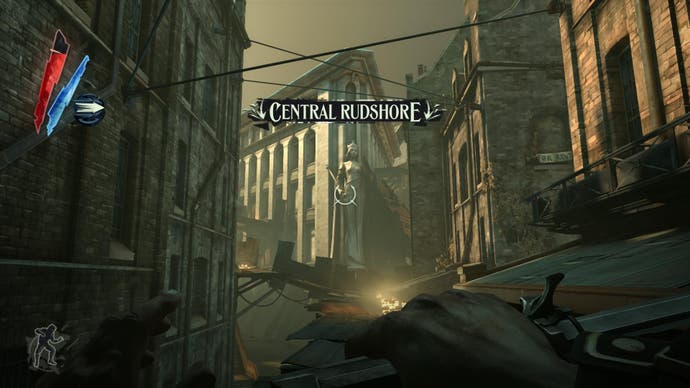
"I think a lot of times we're looking at something and we're curating, basically," says Smith. "We're deciding what to approve or what not to approve, and so everybody moves forward doing their thing, and we work with some really talented guys, and they're all doing the same thing at the same time. So we try to give them a sort of sense of what we're trying to do - the place and the vibe and all that - and if you think about it often our underlying feelings are a little more mythic, so it ended up with the princess in the tower, but it wasn't like we started with that on day one."
One of the things I really like about Dishonored is its designers' willingness - desire, even - to talk about the messiness of the creative process. As modern video games have shaken off the image of the flabby, antisocial misfit lurking on the fringes of pop culture in recent years, so the language adopted by the modern critic has changed too. Games are now "lean", "chiselled", "taut" and "muscular". From Deus Ex to Halo 4, every ounce of fat has been scraped away by hard-earned understanding of the hardware, intense focus-grouping and ceaseless iteration. Even our 'beta' versions - once a term for bug-ridden but feature-complete test software - are now flashy demos in all but name, and the term 'beta' is merely co-opted to enhance the player's sense of importance and inclusion. Publishers want us to look up to and worship games as these powerful and robust entities that emerge fully formed from the godlike minds of developer titans. This is total bollocks.
"You're from Europe so you understand that very well - this is more true over there, where we keep layers of history wherever a place exists."
Raphael Colantonio, Dishonored co-creative director
"Whenever we talk about things like this it's really hard to remember the exact details of these things, because it's such a gradual, iterative process," says Smith. "Raph and I share an office, and we talk for half the day, then we talk to our level designer, then we talk to our art director, and somebody would throw out some little idea that we would then spin out into something else."
Led by Smith and Colantonio, Arkane hasn't just alluded to the messiness of the creative process though - it has hung its hat on it, talking about how the serendipitous clashes of unfinished systems would lead to gameplay ideas that made Dishonored a better game. All the talk of turning bugs into features feels practically counter-cultural, and even if it is partly a marketing gimmick, you can feel how deeply rooted it is into the way Arkane works every time you speak to the developers or play the game. They talk about how the fiction of old High Overseers dying is an allusion to the BioShock team, or how the assassin tutorial in Daud's base is using the dialogue from Thief.
"We talked a lot about how before science was really a known thing, it seemed magical in some ways," says Smith. "We were influenced by Tesla a little bit - he had these various devices and some of them had outlandish names, so when we came up with the Wall of Light it was part science... It was the version of science at the time, natural philosophy, and in part this thing of beauty. If you look at some of those old images from Tesla's lab they're just hauntingly beautiful. And I'm sure part of that is the black-and-white photography and all, but imagine being a person in the 1800s seeing for the first time gas lamps or electricity or hearing a radio for the first time with all the crackle and then a voice out of the dark coming out of it. That would just have been freaky in a way that saying the word 'magic' can't really convey."
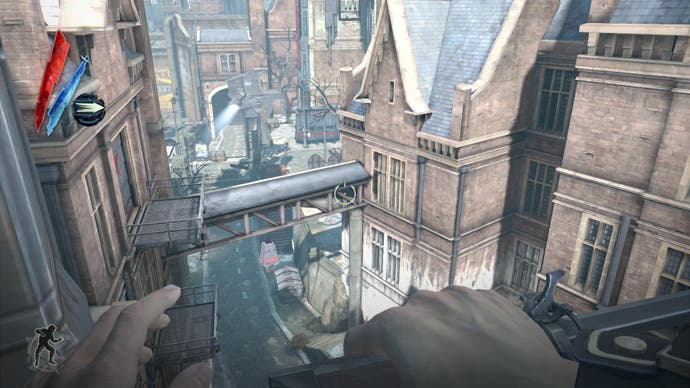
More layers. At times, Dishonored feels like an old regency townhouse, where successive owners have painted over the corbels and dados without stripping them down first, mushing up all the detail so that when you peel back the covering to reveal the original plaster you're suddenly exposed to a cross-section of painted layers, showcasing the tastes and fashions of many different eras.
It's a fascinating experience, and I imagine that, for many players, knowing about the history of the genre and listening to people like Smith and Colantonio talk about it has become an essential part of the game itself. It certainly has for us. It's why hours spent failing to break into an area of the game that isn't even there have so much meaning. It's why we debate whether the non-lethal outcomes to certain levels are actually fates worse than death. It's why we ended up writing 14,000 words in three days about our adventures.
Bethesda doesn't do post-mortems, mind, so we may never know what Demo Dick truly thought of Rogue Warrior. In Dishonored's case, however, it doesn't matter, because the mere fact of playing the game exposes you to one big, long, riveting autopsy of the three and a half years that produced it. We'll happily take that instead. More please.
